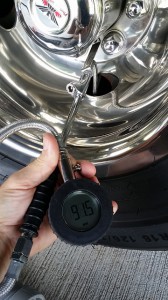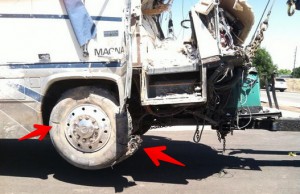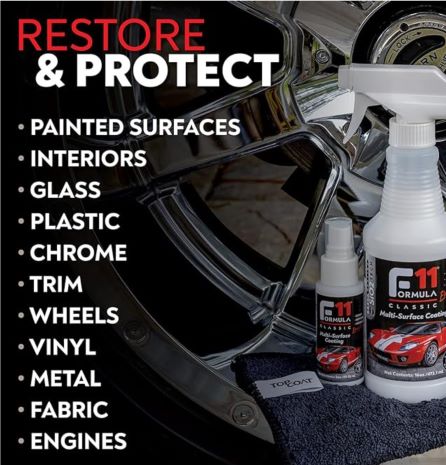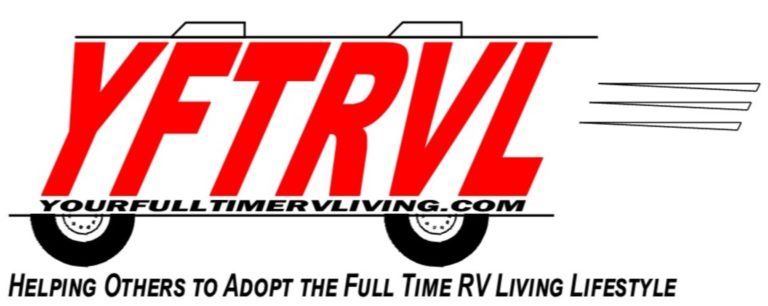When it comes to RV safety on the road, you should be checking your RV tire pressure before each trip! The only thing that allows the loaded RV to travel safely down the road is the air in those tires. Too little or too much RV tire pressure can lead to tire failure. So what is the correct RV tire pressure for your RV? I will get to that shortly!
RV Weight Management
Before you can determine the correct RV tire pressure for your RV tires you have to know how much your RV weighs with all cargo and passengers on board. Some RVers really don’t know how much cargo carrying capacity (CCC) their RV has. They figure if there is space available on the RV then they can put something there. RV safety on the road has a lot to do with the loading of the RV!
Here are some statistics for you:
- Fifty-eight percent of RV owners exceed the weight rating of their RV. That is an average of all RV classes on the road today.
- If that statistic is broken down, fifty-nine percent of motor homes are overloaded, sixty percent for toad vehicles, fifty-one percent for travel trailers and fifty-five percent for 5th wheel trailers.
- It is not unusual for an RV to be out of balance by a thousand pounds or more from side to side.
I can’t stress this enough! It is so important to know what weight is being placed on each tire so you can inflate them to the proper cold tire pressure! Your RV’s data plate will give you the vehicle’s weight when it left the factory, but even there they are not giving you the weight values at each tire position. So, once you have your vehicle loaded and ready for travel take it to a weighing facility where you can have each tire position weighed. With that information, you can inflate your tires based on the tire manufacturers load charts.
“How do I know what RV Tire Pressure to inflate my RV Tires to?”
Depending on the load on each tire, inflate your RV tires to the cold pressure rating listed in the inflation tables for your particular tire. These inflation tables are easy to find on the tire manufacturers website.
Once you know what the correct RV tire pressure values are, inflate to the largest weight value on each side, plus a safety margin of fifteen percent. Hopefully, you have enough there to not exceed the maximum weight value of the tire. If you do not then one of two things may be wrong: you are overloaded or the tires are not the correct type for your RV.

For trailers with factory tires installed, I have read it is best to inflate the tire to the maximum cold pressure rating. Even then, you should know how much weight each tire is carrying so you can verify that the tire weight limits are not being exceeded. I like using a digital tire pressure gauge that will go to 150 psi. They are usually better quality and are more accurate!
Keep in mind that under-inflation is worse than over inflation when it comes to tire life! A tire that is eighty percent or less of what it should be inflated to for the load it is carrying is considered to have been run flat. What this will do is ruin the internal structure of the RV tire if driven in that condition.
Being an RV inspector and teacher, and that I live full time in my RV, I find it easy to get in discussions with my neighbors. My first concern with my RV traveling neighbors is safety! If they want to listen I will gladly share what I have learned.
One park we were staying at I got in a discussion about RV tire pressure with an RVer who had just arrived with his new rig. He swore his RV tires were inflated by the dealer to the correct pressure and he did not need to worry about his current RV tire pressure. So, I bet him a glass of wine that they were not set properly. He was also a new RVer so I was confident I was right. We checked the RV tire pressure on all tires and verified those values with the data plate load specs. He was underinflated on all of his tires.
And yes, I did enjoy the glass of wine!!
What Can Happen if my RV Tires are not set at the Proper RV Tire Pressure Rating?
If your RV tires are not operating at the correct RV tire pressure ratings, several things can happen. If they are under-inflated, the tires will develop excessive heat during travel, they will wear unevenly and have an uneven tire footprint. If they are over inflated then there will be a reduction in vehicle handling, braking and vehicle ride. Over inflation also leads to a smaller tire contact point with the road. In this condition, there can be impact damage to the tire rim when hitting potholes.
About using an RV Tire Pressure Monitoring System?
Pam and I do not move the RV without the RV tire pressure set at their proper values, and the RV tire pressure monitoring system engaged. The only way to know what is going on with our tires during travel is to be able to constantly monitor the RV tire pressure and temperature. This is so important, especially when pulling a fifth wheel or travel trailer. Without that immediate feedback, you can drive many miles before you know that a tire has failed and is doing serious damage to your RV!
To know more about these systems you can visit this page on my website.
I hope this information has been helpful! There is a lot data out there when it comes to RV tire pressure and RV tire safety. Please visit our friends website rvsafety.com for more information on getting your RV weighed. I would also recommend spending some time at rvtiresafety.com to find out more from a tire design engineer who worked in the industry for forty years.
Here’s wishing you safe travels, whether you are enjoying the full time RV living lifestyle or you just hit the road when you can. Be safe!
Blessings,
Howard and Pam
Please feel free to leave a comment before you go!









Recent Comments